Metabolism and Ventilation in Heated Pools
The implementation of Regulations and Standards up to now has not been very rigorous. Solutions have been adopted that, while accepted by the majority, do not always adhere to the required standards. This is one of those cases, and in this instance, it is also related to the ventilation of air-conditioned premises.
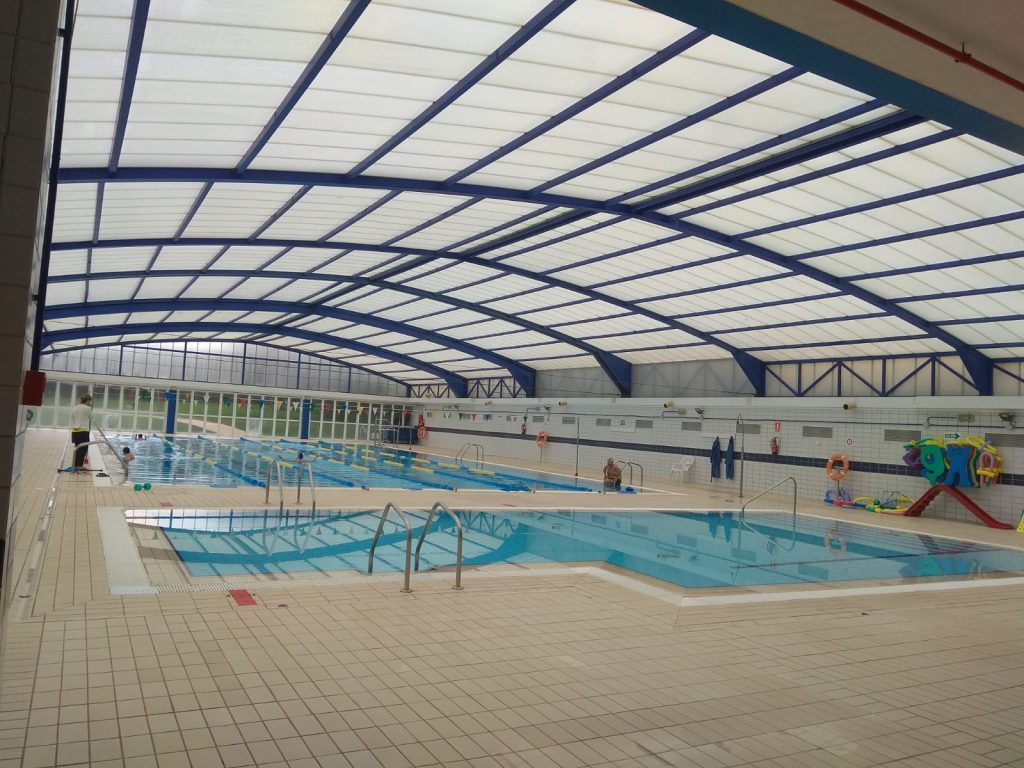
RITE, in its article on indoor air quality requirements, tells us the minimum requirements of each room and how to achieve them, at the level of ventilation rate and filtrations. In the aforementioned article, IT 1.1.4.2.3, heated pools are categorized as ADI2, which indicates that their air must be of good quality and proposes, as for the rest of the environments, to apply one of the five existing methods to determine and achieve the necessary ventilation flow. But at the end of the description of these methods, it indicates that “in heated pools the outdoor ventilation air necessary for the dilution of contaminants will be 2.5 dm3 / s per square meter of surface of the water sheet and the beach (the spectator area is not included). To this flow, the necessary amount to control relative humidity must be added, if applicable. The premises will remain with a negative pressure of between 20 to 40 Pa with respect to the adjoining premises”
At Keyter, as a manufacturer and designer of air conditioning equipment, we closely study all the existing regulations to be able to advise our customers and collaborators in their projects for compliance with the existing Regulations in a rigorous way ensuring the best solution for their applications in terms of efficiency, air quality and comfort of its users. As a result of these studies carried out by Keyter’s special projects department, certain points raised by the RITE for the ventilation of heated pools have been detected that are not entirely clear, and may be contradictory or obsolete today.
We understand that they are not clear since they make us ask ourselves the following questions:
– Is the VENTILATION of ADI 2 applied and is the aforementioned surface ventilation added for pollutants other than CO2 from human activity that may exist in a heated pool?
– Is ventilation only taken by surface?
If the answer is the first, then the text must be qualified and expressly indicate the additive nature of the ventilation rates.
If the answer is the second, we understand that this aspect must be taken up again and the ventilation needs of heated pools must be reconsidered.
From Keyter, we have carried out an analysis of the methods that RITE makes available to us to calculate this minimum necessary ventilation:
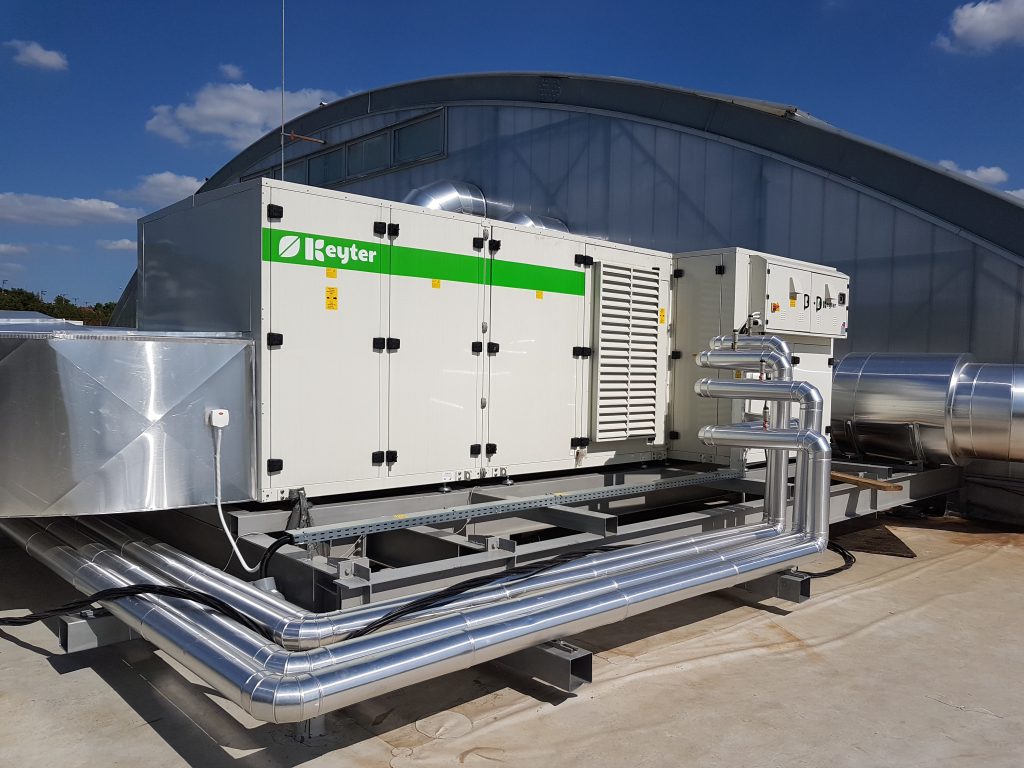
Indirect method of outdoor air flow per person: The clearest of all and where the supports our defense I will lean for my exhibition. The body of the article indicates that “The values in Table 1.4.2.1 will be used when people have a metabolic activity of around 1.2 met, when the production of pollutants by sources other than humans is low and when smoking is not allowed.
We attach to the table of ADIs the equivalent values in m³/h.
| Category | dm³/s per person |
|---|---|
| IDA 1 | 20 (72 m³/h) |
| IDA 2 | 12,5 (45 m³/h) |
| IDA 3 | 8 (28.8 m³/h) |
| IDA 4 | 5 (18 m³/h) |
According to this method, the rate of ventilation per person does not depend only on the person, or the number of people, but the activity developed also enters the equation.
The reference metabolic activity is the MET, quantified by RITE at 58.2 W/m², and which depending on the surface of the human skin (1.8 m² for men and 1.6 m² for women) is estimated at 104.76 W/person and 93.12 W/person respectively and as a result of applying factor 1.2 is 125.71 W/person and 111.74W/person.
This would be the energy expenditure of a person in sedentary activity, for other activities we can find information in the UNE EN ISO 7730: 2006 Analytical determination and interpretation of thermal well-being by calculating the PMV and PPD indices and the criteria of thermal well-being, where it is shown, in its Annex B, the following table with metabolic rates for different activities.
| Activity | Metabolic rate | |
|---|---|---|
| W/m² | met | |
| Resting, lying down | 46 | 0,8 |
| Rest, seated | 58 | 1,0 |
| Sedentary activity (office, home, school, laboratory) | 70 | 1,2 |
| Light activity, standing (shopping, laboratory, light industrial) | 93 | 1,6 |
| Medium activity, standing (shop assistant, housework, machine work) | 116 | 2,0 |
| Walking on the flat | ||
| 2 km/h 3 km/h 4 km/h 5 km/h |
||
| 110 | 1,9 | |
| 140 | 2,4 | |
| 165 | 2,8 | |
| 200 | 3,4 | |
Source: UNE EN ISO 7730:2006, Annex B
As can be seen, an activity such as walking at 5 km/h, already involves almost tripling that 1.2 met, and therefore our CO₂ emissions increase. How do they increase?, proportionally. This is indicated by ADIE in its Recognized Document of Comments to the RITE.
“If metabolic activity is greater than 1.2 met, ventilation air rates should be increased by a proportionality factor equal to the ratio of the considered metabolism value (in met) divided by 1.2. That is, indicating with CV the ventilation air flow of the previous table valid for a metabolic activity of 1.2 met, the ventilation air flow CVn for another met metabolism value will be:

Where:
New ventilation flow (m³/h)
Ventilation flow according to ADI (1.2 met) (m³/h)
New activity metabolic rate (MET)
This is where the contradictions begin to jump, the ventilation rates are rarely those indicated in the RITE table, referring to 1.2 MET, in fact, the table is really a graph like the following.
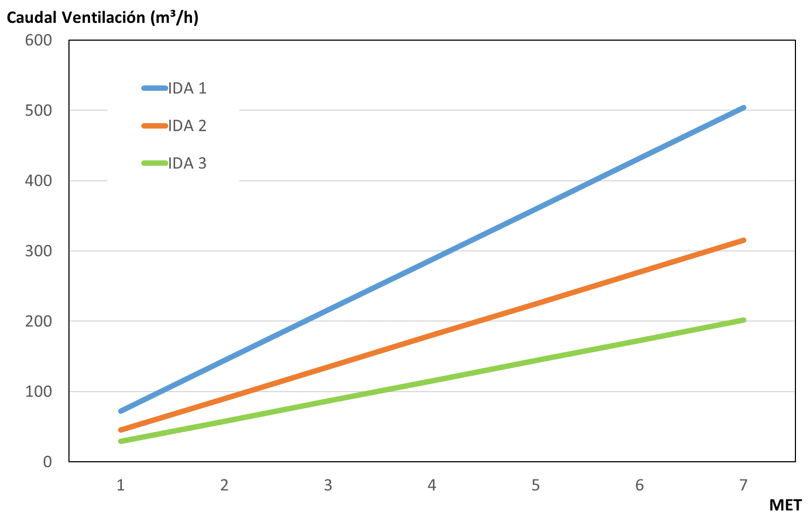
Therefore, the problem focuses on finding and identifying the metabolic rates of the different activities that are carried out in the room to be air-conditioned.
In the case of heated pools, we will use the study by Sergei Kolmogorov, Andrei Vorontsov and João Paulo Vilas-Boas, published in MDPI (Multidisciplinary Digital Publishing) in November 2021, under the title of Metabolic Power, Active Drag, Mechanical and Propelling Efficiency of Elite Swimmers at 100 Meter Events in Different Competitive Swimming Techniques
In the text it is indicated that the results obtained, for women and men, at the level of metabolic power are, depending on the speed and style of swimming of:
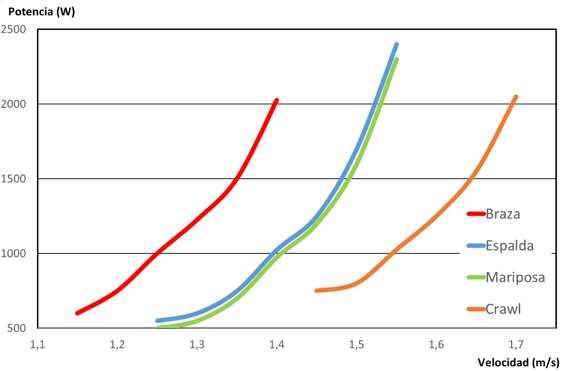
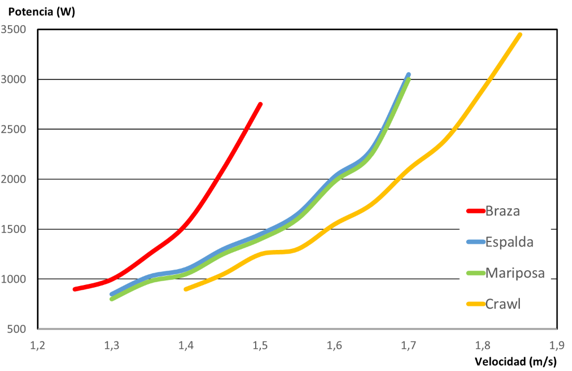
This translated to MET values, (58.7 W/m2), gives us the following results.
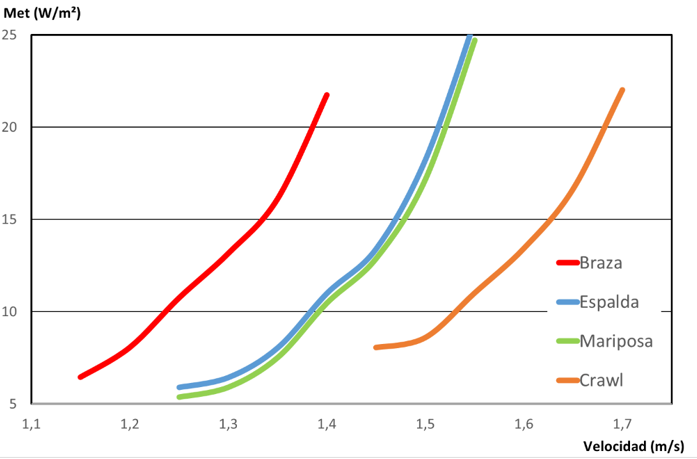
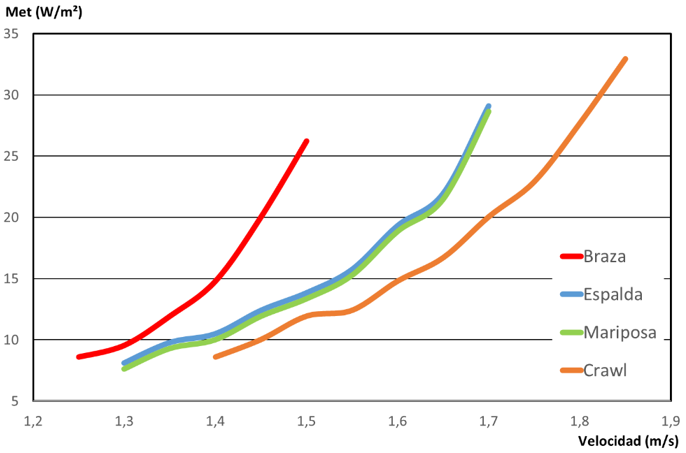
Therefore, the ventilation values in heated pools depending on the metabolic activity developed would be, as a guideline:
Let’s look at an assumption:
• Olympic Swimming pool (50x21m), with 8 lanes, with an average poolside width of 1.5 m
• 5 people from the facility
• 9 swimmers training
Let’s analyze the different ways to calculate ventilation:
Area fee criterion:
– Surface Rate: “2.5 dm³/s per square meter of surface of the water sheet and the poolside (the spectator area is not included).”
ADI2 criterion with metabolic rate:
• Metabolic rate depending on the activity developed
Let’s take another case with the same pool:
• Olympic Swimming pool (50x21m), with 8 streets, with an average beach width of 1.5 m
• 5 people from the facility
• 58 people practicing Aquagym
Let’s analyze the different ways to calculate ventilation:
Area fee criterion:
– Surface Rate: “2.5 dm3/s per square meter of surface of the water sheet and the beach (the spectator area is not included).”
IDA2 criterion with metabolic rate:
• Metabolic rate depending on the activity developed
We can therefore deduce that the mere application of point 2 of Article IT 1.1.4.2.3 Minimum flow rate of ventilation outside air, on its own, is insufficient for the following reasons:
– Unifies the ventilation of the pools only by their surface. Which at first does not seem correct.
– Does not take into account the metabolic activity of the occupants
– Fails to comply with what is indicated in the Recognized Document Comments to RITE-2007, which cites:
“If metabolic activity is greater than 1.2 met, the ventilation air rates indicated above should be increased by a proportionality factor equal to the ratio of the considered metabolism value (in met) divided by 1.2. That is, indicating with CV the ventilation air flow of the previous table valid for a metabolic activity of 1.2 met, the ventilation air flow CVn for another met metabolism value will be:

In short, after our analysis by the Special Projects Department of Keyter, whose head is Jose Jesús Arboledas, we understand that the correct reading of IT 1.1.4.2.3 is the first one we proposed. ADI 2 ventilation is applied and surface ventilation is added for pollutants other than CO2 from human activity that may exist in a heated pool.
In this way RITE would not enter into contradiction and the heated pools would be properly ventilated.
KEYTER has pool dehumidifiers capable of providing these ventilation air flows required in any of the existing pool formats. Ocean Dehumidifiers for the control of air temperature and humidity focused on the integral air conditioning of indoor swimming pools, sports facilities, gyms, spas, spas, hotels, etc., Highly configurable and adaptable, with a wide variety of assemblies can integrate sections of filtering, mixing, dehumidification, heating, post-heating if necessary, freecooling and energy recovery. They can be installed in indoor or outdoor machine rooms adapting to the needs of each installation. They are available with reduced height to be installed in a gallery of indoor pools of reduced dimensions or difficult access.
Keyter’s OCEAN units are highly efficient and has the possibility of energy recovery from exhaust air with reversible active recovery or by means of a cross-flow plate exchanger, heat recovery for heating the water from the pool glass or free cooling and dehumidification by outside air. They are also available with expansion valve and fans, both with electronic control, for minimum energy consumption.
More articles
Interested in other (technical) knowledge articles? Keep yourself up to date and read them all.






